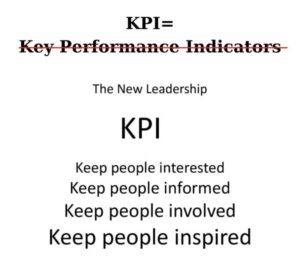At this point in our careers, we’re likely well-versed in Key Performance Indicators (KPIs). According to Oxford Language, a Key Performance Indicator is “a quantifiable measure used to evaluate the success of an organization, employee, etc. in meeting objectives for performance.” KPIs usually fall within five categories: sales, financial, customer, operational, and marketing. Data related to revenue growth, profit margin, customer satisfaction, and employee retention has been a long-time indicator of whether a company is thriving or surviving. Leadership and their teams spend months to even years gathering and analyzing KPIs to make business decisions and chart potential growth.
Capture the Stories behind the Numbers
Oftentimes, KPIs don’t travel well into an organization, and leaders spend too much time reviewing the numbers rather than bringing clarity, meaning, or inspiration to them and what they represent.
Your KPIs only go as far as your ability to connect people meaningfully to your ambitions.
And at the core of that is not the metric, but it’s a sense from your people that you truly care about and value them. Think of your people as the hundreds or thousands of stories that give the KPIs life. The questions then become, how curious are you about those stories? How well do you nurture those stories? How do you celebrate those stories?
I saw an image on LinkedIn that captured this spirit well.

It is a great list, and one we can easily add to:
- Keep your people imaginative
- Keep your people innovating
- Keep your people impactful
- Keep your people inquisitive
- Keep your people improving
Be More like Fantasy Football
One frustration I often hear from leaders is that their business can be complicated, and people simply will not understand. I counter that point with a story of my company’s fantasy football league. We’ve had our Root league for years, and anyone from entry-level folks to executives participate in it. For those not familiar with fantasy football, you start a team of players every week and gather points depending on their weekly performance. If one of your players scores a touchdown or catches a long pass, for example, that is a good thing.
As a disclaimer, all of us participating in fantasy leagues largely understand the ridiculousness of the enterprise, but we love it. Spouses and significant others can’t quite fathom why people can care that much about something that is entirely fantasy, but that is for another blog.
Doing well in fantasy football requires you to look at many players and quantitative numbers to consider who you might pick up or drop on your team, or any trades you might make to give you the best chance to win. It’s rather sophisticated, and a bit like poker where anyone can win any given hand. But over time, quality wins out. The point of this anecdote is that there is no meaningful difference in playing this game well based on where you sit within an organization. Whether you are the CEO or an entry-level employee, your position in the company makes no difference in who comes out on top in the league. In the case of fantasy football, sophisticated concepts are well-grasped by people deep in your organization because they are interested in the outcome and feel informed, involved, and inspired.
So, as you think about your KPIs, be sure to think as much about how you engage people in them as the metrics themselves. Otherwise, they are simply numbers on a screen that give you an assessment of your work, and they won’t help you drive your performance.
When gathering with your leadership team to discuss your next round of KPIs, encourage everyone to think broader. Ask yourselves what you can do differently to keep your people [fill in the blank].








